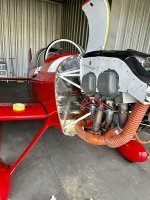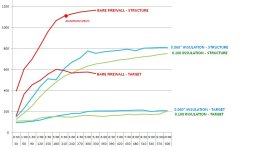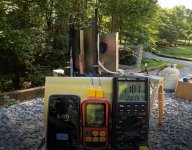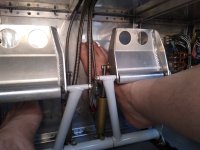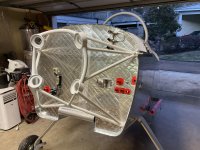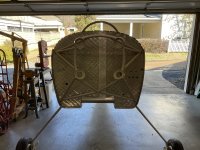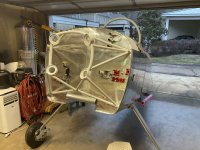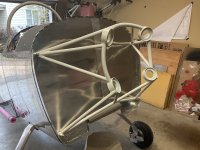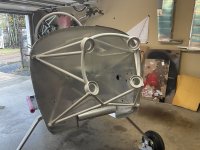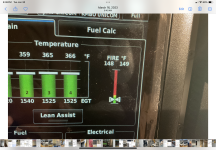Has anyone actually successfully bailed out of an RV-8?
Do you think it can't be done? There are threads galore on the topic. The tragic RV8 bailout (on fire & no parachute) I mention above would have, I assume, been successful, if he had a chute. I recall postmortem on final report, pilot had signs of being burned and smoke inhalation in lungs. I am sure w/ a chute he would have got out sooner. I'm also sure firewall insulation would not have helped.
So yes I 100% believe it is possible and a life saver to bailout of RV's with a chute. Has anyone done it out of an RV? Don't know. I offer more would if they had a sport parachute on abd might otherwise be alive. 1000's of pilots have used emergency chutes to save their life. This is well established "thing" for over 100 years.
Legally (and smart) you and your passenger are REQUIRED by FAR's to wear a chute IF DOING AEROBATICS. Solo? No chute REQUIRED for aerobatics. If doing training for a rating (CFI required spin training) chutes not required. I think all RV pilots doing aerobatics should have an emergency chute even solo, take a seminar and training on how to use it, have a plan to get out (canopy release).
Chute makers who offer Pilot Emergency Parachutes: National, Strong, Softie (Para-Phernalia), PARI Precision Aerodynamics, MarS, etc.
have LONG lists of saves... So yes it is a safety device that works regardless of make model of plane.
A bizarre RV accident I recall, reading NTSB accident report, plane (RV) crashed and pilot (no chute) was a mile away. Went thru canopy. Seat belt NOT on/secure and did impromptu aerobatics? I don't recall if there was finding od why. Point yes you can exit RV's in flight. Yes a chute will save your life.
The question is can you successfully bailout of any RV. Not with standing the obvious have a chute, I say yes with exceptions.
RV3 and RV4 the canopy is opened and rips off side piano hinge. I know the can come off as several canopies departed in flight inadvertently over the decades. Most of the time pilot landed safely. Know of no intentional bailouts.
RV6, RV7, and RV9 tip up has canopy ejection handle (or can have one installed). The Slider canopy at speed, will not open very far. You need to add ability to disconnect fwd slider attachments x2 and open overhead latch, 3 step process.
RV14 I assume has ejection tip up canopy design as before. There is no RV14 slider.
I just flew an RV12 yesterday. First flight of aircraft. I'm doing the builder/owners training and flight test. No way to bailout, jettison canopy in stock form. With mods yes I assume. RV12 is Non aerobatic plane. See below, we *me and owner* had smoke, burning

smell during 1st flight.
RV10 I don't believe you can bailout unless you put in a way to jettison doors. Non aerobatic plane.
C 152 "Aerobat" has jettisonable doors. Handle pulls cable and pulls 2 pins out of the 2 fwd hinges.
How many military planes don't have ejection seats? Some. Still ejection or jumping and hitting the silk is time honored method of saving pilots bacon that works. There are 1000's of military and civilian pilots who lives were saved by a parachute.
If you are worried about a massive fire  I would take a parachute over firewall insulation!!!!!!
I would take a parachute over firewall insulation!!!!!!
BTW On 0.6 hr first flight of the RV12 I flew yesterday, there was a hint of a burning smell for a moment about 20 min into planned 30 min flight. The exhaust toasted a half dollar sized area in cowl. Builder knew this area of cowl got hot from previous taxi and ground runs. So he wrapped exhaust. It did not get better in flight. Discoloration of paint turned black  . Needless to say he is doing modification repairing. That wiff of smoke although momentary shows SMOKE GETS INTO COCKPIT, EVEN A LITTLE SMOKE, MUCH LESS RAGING GAS OIL FIBERGLASS FIRE.
. Needless to say he is doing modification repairing. That wiff of smoke although momentary shows SMOKE GETS INTO COCKPIT, EVEN A LITTLE SMOKE, MUCH LESS RAGING GAS OIL FIBERGLASS FIRE.
In event of an engine fire, it is a few feet from your feet and face. There are leaks in canopy and firewall. That propeller and airflow is blowing at hurricane force that fire and smoke at YOU. My ideawould be GET THE FUDGE OUT, E.G., PARACHUTE.
Yes I owned a chute, used it often, but mostly aerobatics. I sold the chute with my RV. I need a new light slim type (Softie mini). I don't wear a chute always especially long XC trips. But a Softie Mini is 14lbs and could be worn always. The new slim and wedged backpack emergency chutes are comfortable, but you have another harness plus seat belts. You get use to it. I always put chute on before getting in and get out with it on. Always store chute in hard case (like a big suitcase) in your heated cooled controlled home.
I need a new chute. The Para-Phernalia emergency backpack shell I had is *no longer made*. It had a new surplus w/ 28' military high opening speed (jet) canopy. More bulk and weight. Bad part chutes are several grand now. A Mini is +$3K, most in the $2K to $2.5k range. Airshow specials is good time to buy,
I am sure if more sport experimental pilots wore and trained in how to use emergency chutes lives would be saved, more lives than firewall insulation. 
PSS Bailout not only for fire, if you have a Mid-Air, Structural Failure, Flight Control System "jam" or disconnect, loss of engine power (no fuel) at **altitude** BAILOUT might be a good option.
** How low can you get out? About 1000 feet **if** aircraft (and you) have a vector that is horizontal to ground with forward speed. If you get out at 150 kts going straight towards the ground you will need much more altitude. It is just math and physics. Chutes have strict demonstrated open times per TSO and FAR's... So you could in theory step out of your RV in the pattern at 1000 ft AGL, pull rip cord, swing one or two times under canopy, before back on mother earth in time to see your pride and joy auger in (or fly off on autopilot and land itself in a field 300 miles away). Laugh look this up https://en.wikipedia.org/wiki/Cornfield_Bomber



